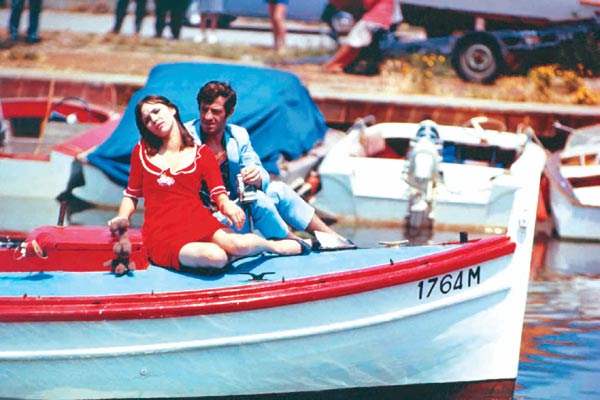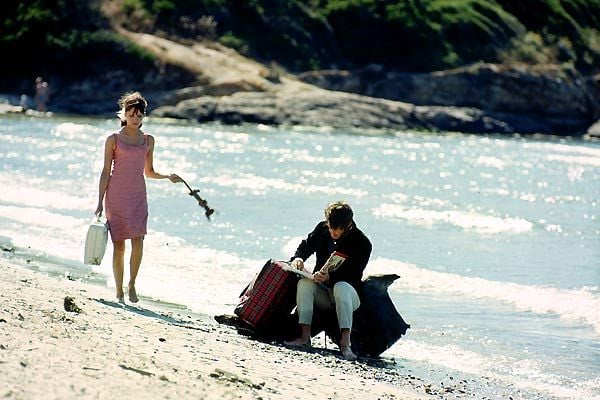
Pierrot le fou (Pierrot Goes Crazy), 1965
Dir: Jean Luc-Godard
September 13, 2009
Let me start by saying that I'm pretty sure I enjoyed most of this film. The entirely simple set up of "love on the run," like Badlands (1973) or Bonnie and Clyde (1967) lets the film flesh out to levels that I would not expect from a Godard film, and the beautiful color photography makes me think that he should have made more than just Contempt (1963) before this in color. This is juxtaposed with French New Wave absurdity and the high-mindedness that is typical Godard (at one point the main male character reads art criticism in the bath tub to his young daughter). Yet the genre conventions that typically structure (or deter them, like in Alphaville (1965)) his films is thrown out the window for something more self-referential. By the time he started shooting Pierrot le fou, he said that the film noir conventions underlying it no longer inspired him, and his theoretical references were in a state of flux due to his political anger as the Vietnam War escalated. So you can say that this film is a crossroads for him, where his political beliefs began to be the main driving force of his vision, and there are obvious signs in the film.
I did not know exactly what the name "Pierrot" meant, especially in the context of the film (or even Godard's real life). It of course relates much more to the road movie/genre structure that is what all past Godard films are about, and again, Godard felt hollow about it since writing the script. So instead of channeling all of the emotions through character, he does it through direction. Godard gave unusually free vent to his emotions, and those emotions were harrowing ones: Pierrot le fou was an angry accusation against Anna Karina (infidelity), and a self-pitying cry at how she destroyed him and his work. Nothing like this would have appeared in a previous work.
Of course, for me, I am far more interested in cinema conventions than what is sure to become a butt-load of Marxist bullshit. After going to a boring party with his wife, Ferdinand (cool as a cucumber Jean-Paul Belmondo), an advertising man and failed writer, comes home early and falls for a teenage girl (Anna Karina), his children's babysitter. This girl has underworld connections and an aptitude for deception and manipulation; after he leaves his family for her, gets caught up with her in a murder and goes on the lam with her, she uses, betrays, and abandons him. Desperate and humiliated, he catches up to her and kills both her longtime lover (who she had claimed was her brother) and the girl herself before finishing himself off. So, yeah, pretty awesome stuff. Godard, with his new direction, changed Ferdinand at the last second to reflect himself. He becomes a failed intellectual who rediscovers his literary ambitions along with his romantic passion. Marianne not only breaks Ferdinand’s heart but also destroys what was to be his life’s work. The romantic exaltation that Godard thought the casting of Karina and Belmondo had substituted for the story of betrayal and depredation turned into an artistic manifesto and a cry of resentment and pain. By the time he shot the film, from May through July 1965, he and Karina had divorced.
The core of the film (the best part, really) is a scene that takes place in the tranquil natural splendor of unspoiled lands in the south of France. Ferdinand and Marianne live off the land, hunting and fishing (albeit cartoonishly—like most of the film’s narrative action), while Ferdinand (sitting with a parrot on his shoulder) begins to keep a journal, which appears in extreme close-up on-screen, and which is in fact in Godard’s handwriting. Among the passages that Ferdinand reads aloud is a description of his ambitious plans for a new form of novel: “Not to write about people’s lives anymore, but only about life—life itself. What lies in between people: space, sound, and color. I’d like to accomplish that. Joyce gave it a try, but it should be possible to do better.” Annoying in that Godard way, yet clearly stating his new goals: for a new type of cinema. This is all good and grand and ambitious (which you have to respect) but not really interesting to me in it's execution. But I can't get over the setting. It's the perfect romantic device, like the tree-house in Badlands. The sequence is the crowning moment in Ferdinand’s dream: the couple will exist together, in isolation at a wild seaside, where the setting and romantic idleness will inspire Ferdinand’s artistic creation. I really did not expect this from Godard, and I think that it goes without saying, that when it comes to cinema, I am a hopeless romantic. The film descends into tragic cinematic romanticism, which unfolds just as a noir should, which works all too well for me.





I did not know exactly what the name "Pierrot" meant, especially in the context of the film (or even Godard's real life). It of course relates much more to the road movie/genre structure that is what all past Godard films are about, and again, Godard felt hollow about it since writing the script. So instead of channeling all of the emotions through character, he does it through direction. Godard gave unusually free vent to his emotions, and those emotions were harrowing ones: Pierrot le fou was an angry accusation against Anna Karina (infidelity), and a self-pitying cry at how she destroyed him and his work. Nothing like this would have appeared in a previous work.
Of course, for me, I am far more interested in cinema conventions than what is sure to become a butt-load of Marxist bullshit. After going to a boring party with his wife, Ferdinand (cool as a cucumber Jean-Paul Belmondo), an advertising man and failed writer, comes home early and falls for a teenage girl (Anna Karina), his children's babysitter. This girl has underworld connections and an aptitude for deception and manipulation; after he leaves his family for her, gets caught up with her in a murder and goes on the lam with her, she uses, betrays, and abandons him. Desperate and humiliated, he catches up to her and kills both her longtime lover (who she had claimed was her brother) and the girl herself before finishing himself off. So, yeah, pretty awesome stuff. Godard, with his new direction, changed Ferdinand at the last second to reflect himself. He becomes a failed intellectual who rediscovers his literary ambitions along with his romantic passion. Marianne not only breaks Ferdinand’s heart but also destroys what was to be his life’s work. The romantic exaltation that Godard thought the casting of Karina and Belmondo had substituted for the story of betrayal and depredation turned into an artistic manifesto and a cry of resentment and pain. By the time he shot the film, from May through July 1965, he and Karina had divorced.
The core of the film (the best part, really) is a scene that takes place in the tranquil natural splendor of unspoiled lands in the south of France. Ferdinand and Marianne live off the land, hunting and fishing (albeit cartoonishly—like most of the film’s narrative action), while Ferdinand (sitting with a parrot on his shoulder) begins to keep a journal, which appears in extreme close-up on-screen, and which is in fact in Godard’s handwriting. Among the passages that Ferdinand reads aloud is a description of his ambitious plans for a new form of novel: “Not to write about people’s lives anymore, but only about life—life itself. What lies in between people: space, sound, and color. I’d like to accomplish that. Joyce gave it a try, but it should be possible to do better.” Annoying in that Godard way, yet clearly stating his new goals: for a new type of cinema. This is all good and grand and ambitious (which you have to respect) but not really interesting to me in it's execution. But I can't get over the setting. It's the perfect romantic device, like the tree-house in Badlands. The sequence is the crowning moment in Ferdinand’s dream: the couple will exist together, in isolation at a wild seaside, where the setting and romantic idleness will inspire Ferdinand’s artistic creation. I really did not expect this from Godard, and I think that it goes without saying, that when it comes to cinema, I am a hopeless romantic. The film descends into tragic cinematic romanticism, which unfolds just as a noir should, which works all too well for me.





Despite what I think about parts of the film, it is filled with contradictions. It's sort of a gangsterish-genre film that Godard no longer believed in and a new kind of cinematic form that he couldn’t yet find. The self-searching of Ferdinand in the mirror, his allusion to Poe’s “William Wilson,” about a man and his double, make it all come back to Godard and his new cinematic torment. Pierrot le fou was the work of a divided person whose film fell into the abyss of his own character. Ferdinand's self-immolation at the end almost seems like Godard's career, which he had just blown up to try and forge a new one. You can call a film like this ballsy, ambitious, and even really good (you have to give Godard credit for going with his gut; can you picture the Coens doing this? I didn't think so...), but a film that really doesn't know what it is can't be called great (at least by me.)


No comments:
Post a Comment